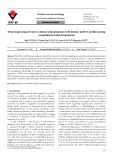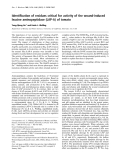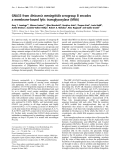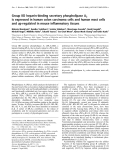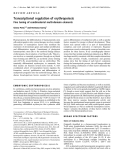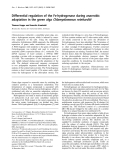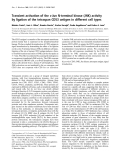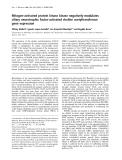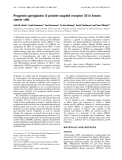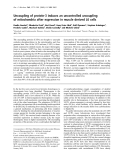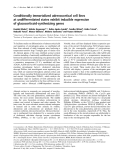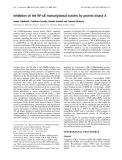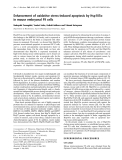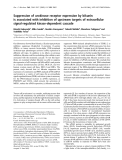
Inducible expression
-
Nuclear factor erythroid-2 related factor 2 (Nrf2) is a crucial transcription factor that regulates the expression of defensive antioxidants and detoxification enzymes in cells. In a previous study, we showed that expression of the Nrf2 gene is regulated by an epigenetic modification. Rauvolfia verticillata, a traditional Chinese herbal medicine widely used in China, possesses anticancer and antioxidant effects. In this study, we investigated how Nrf2 is epigenetically regulated by reserpine, the main active component in R. verticillata, in mouse skin epidermal JB6 P+ cells.
 11p
11p  caothientrangnguyen
caothientrangnguyen
 09-05-2020
09-05-2020
 17
17
 2
2
 Download
Download
-
MicroRNAs (miRNAs) are small noncoding RNAs of about 19–25 nt that regulate gene expression posttranscriptionally under various cellular conditions, including apoptosis. The miRNAs involved in modulation of apoptotic events in T cells are partially known.
 10p
10p  nutifooddau
nutifooddau
 27-01-2019
27-01-2019
 27
27
 2
2
 Download
Download
-
An optogenetic upgrade for the tet - OFF system fused the inhibitor to the blue light-responsive B-LID degron and optimized the performance of this construct with regard to the number of Med25VBD repeats. This approach resulted in an optogenetic upgrade of the popular Tet-OFF (TetR-VP64, tetO7-PhCMVmin) system that allows tunable, blue light-inducible gene expression in HEK-293T cells.
 5p
5p  thuyancn
thuyancn
 01-06-2015
01-06-2015
 30
30
 5
5
 Download
Download
-
High-Level Recombinant Protein Production in CHO Cells Using Lentiviral Vectors and the Cumate Gene-Switch developed an efficient system to generate in less than 2 months, starting from the cDNA, pools of CHO cells stably expressing high-level of recombinant proteins. It is based on lentiviral vectors (LVs) for stable transduction coupled with the cumate gene-switch for inducible and efficient gene expression.
 13p
13p  thuyancn
thuyancn
 01-06-2015
01-06-2015
 36
36
 3
3
 Download
Download
-
A novel vector platform for vitamin H-inducible transgene expression in mammalian cells have therefore designed a strategy to convert antibiotic-responsive transcription factors into gene regulation systems responsive to non-toxic biotin, also known as vitamin H.
 9p
9p  thuyancn
thuyancn
 01-06-2015
01-06-2015
 44
44
 5
5
 Download
Download
-
The importance of two putative Zn2+-binding (Asp347, Glu429) and two catalytic (Arg431, Lys354) residues in the tomato leucine aminopeptidase (LAP-A) function was tested. The impact of substitutions at these positions, corresponding to the bovine LAP residues Asp255, Glu334, Arg336, and Lys262, was evaluated in His6–LAP-A fusion proteins expressed in Escherichia coli. Sixty-five percent of the mutant His6–LAP-A proteins were unstable or had complete or partial defects in hexamer assembly or stability. The activity of hexameric His6–LAP-As on Xaa-Leu and Leu-Xaa dipeptides was tested.
 11p
11p  system191
system191
 01-06-2013
01-06-2013
 41
41
 4
4
 Download
Download
-
In a previous study, we used the genome of serogroup B Meningococcus to identify novel vaccine candidates. One of these molecules, GNA33, is well conserved among Meningococcus B strains, other Meningococcus serogroups and Gonococcus and induces bactericidal antibodies as a result of being a mimetic antigen of the PorA epitope P1.2. GNA33 encodes a 48-kDa lipoprotein that is 34.5% identical with membrane-bound lytic transglycosylase A (MltA) from Escherichia coli. In this study, we expressed GNA33, i.e....
 10p
10p  system191
system191
 01-06-2013
01-06-2013
 37
37
 4
4
 Download
Download
-
Group IID secretory phospholipase A2 (sPLA2-IID), a heparin-binding sPLA2 that is closely related to sPLA2-IIA, augments stimulus-induced cellular arachidonate release in a manner similar to sPLA2-IIA. Here we identified the residues of sPLA2-IID that are responsible for heparanoid binding, are and therefore essential for cellular function.
 10p
10p  system191
system191
 01-06-2013
01-06-2013
 38
38
 5
5
 Download
Download
-
Haematopoiesis, the differentiation of haematopoietic stem cells and progenitors into various lineages, involves complex interactions of transcription factors that modulate the expression of downstream genes and mediate proliferation and differentiation signals. Commitment of pluripotent haematopoietic stem cells to the erythroid lineage induces erythropoiesis, the production of red blood cells. This process involves a concerted progression through an erythroid burst forming unit (BFU-E), an erythroid colony forming unit (CFU-E), proerythroblast and an erythroblast....
 12p
12p  research12
research12
 01-06-2013
01-06-2013
 49
49
 4
4
 Download
Download
-
Chlamydomonas reinhardtii, a unicellular green alga, contains a hydrogenase enzyme, which is induced by anaerobic adaptation of the cells. Using the suppression subtractive hybridization (SSH) approach, the differential expression of genes under anaerobiosis was analyzed. A PCR fragment with similarity to the genes of bacterial Fe-hydrogenases was isolated and used to screen an anaerobic cDNA expression library of C. reinhardtii.
 11p
11p  research12
research12
 01-06-2013
01-06-2013
 42
42
 6
6
 Download
Download
-
The CD53 antigen is a member of the tetraspanin membrane protein family that is expressed in the lymphoid-myeloid lineage. We have studied the implication of CD53 antigen in signal transduction by determining the effect of its ligation on the c-Jun N-terminal kinase (JNK) in different cell types. Ligation of the rat or human CD53 antigen induces a threeto fourfold transient activation of JNK activity that peaks at 3–5 min. The effect was detected by assaying the endogenous or exogenous (transfected) JNK activity....
 10p
10p  research12
research12
 01-06-2013
01-06-2013
 44
44
 6
6
 Download
Download
-
The expression of the choline acetyltransferase (ChAT) enzyme that synthesizes the neurotransmitter acetylcholine (ACh) is upregulated by ciliary neurotrophic factor (CNTF). We studied the involvement of the mitogen-activated protein kinase (MAPK) pathway in regulating ChAT expression in a murine septal cell line. Surprisingly, we found that PD98059 and U0126, two structurally distinct inhibitors of MAPK kinase (MEK1), increased both basal and CNTF-induced ACh production.
 9p
9p  research12
research12
 01-06-2013
01-06-2013
 31
31
 4
4
 Download
Download
-
Undifferentiated human promyelocytic leukemia HL-60 cells show little or no superoxide production, but generate a very low O2 – concentration upon incubation with all-trans-retinoic acid (ATRA). Its production reaches a maximum within 20 h, and thereafter is maintained at an almost con-stant level. The differentiated cells show phorbol 12-myri-state 13-acetate (PMA)-stimulatedNADPHoxidase activity consistent with the amount of gp91phox(phagocytic oxid-ase) expressed in the plasma membrane.
 8p
8p  research12
research12
 29-04-2013
29-04-2013
 36
36
 5
5
 Download
Download
-
A differential display method was used to study genes the expression of which is altered during growth inhibition induced by medroxyprogesterone acetate (MPA). A tran-script of G-protein-coupled receptor 30 (GPR30) was upregulated by MPA in estrogen-treated MCF-7 breast cancer cells. Northern-blot analysis showed a progestin-specific primary target gene, which was enhanced by prog-esterone and different progestins, but not by dihydrotestos-terone or dexamethasone, and which was abrogated by antiprogestin RU486....
 6p
6p  research12
research12
 29-04-2013
29-04-2013
 46
46
 2
2
 Download
Download
-
The uncoupling proteins (UCPs) are thought to uncouple oxidative phosphorylation in the mitochondria and thus generate heat. One of the UCP isoforms, UCP3, is abun-dantly expressed in skeletal muscle, the major thermogenic tissue in humans. UCP3 has been overexpressed at high levels inyeast systems,where it leads to theuncouplingof cell respiration, suggesting that UCP3may indeed be capable of dissipating the mitochondrial proton gradient.
 9p
9p  research12
research12
 29-04-2013
29-04-2013
 40
40
 3
3
 Download
Download
-
To facilitate studies on dierentiation of adrenocortical cells and regulation of steroidogenic genes, we established cell lines from adrenals of adult transgenic mice harboring a temperature-sensitive large T-antigen gene of simian virus 40. Adrenal glands of the mice exhibited normal cortical zonation including a functionally undierentiated cell-layer between the aldosterone-synthesizing zona glomerulosa cells and the corticosterone-synthesizing zona fasciculata cells.
 13p
13p  research12
research12
 29-04-2013
29-04-2013
 44
44
 2
2
 Download
Download
-
The cAMP-dependent protein kinase (PKA) signaling pathway plays a major role in a number of pathophysio-logical conditions. However, there have been conflicting evidences regarding the action of cAMP/PKA on nuclear factor-jB(NF-jB). Inthis study,wehaveexplored the effect of cAMP/PKA on NF-jBactivity and determined its molecular mechanism. PKA activating agents or expression of thecatalyticsubunitofPKA(PKAc) inhibitedtheNF-jB-dependent reporter gene expression induced by tumor nec-rosis factora(TNFa). ...
 7p
7p  research12
research12
 23-04-2013
23-04-2013
 33
33
 4
4
 Download
Download
-
Hsp105aisoneof themajormammalianheat shockproteins that belongs to the HSP105/110 family, and is expressed at especially high levels in the brain as compared with other tissues in mammals. Previously, we showed that Hsp105a prevents stress-induced apoptosis in neuronal PC12 cells, and is a novel anti-apoptotic neuroprotective factor in the mammalian brain.
 9p
9p  research12
research12
 23-04-2013
23-04-2013
 43
43
 1
1
 Download
Download
-
InSaccharomyces cerevisiae, toxic concentrations of Na + or Li + ions induce the expression of the cation-extrusion ATPase gene,ENA1. Several well-studied signal transduc-tion pathways are known correlating high salinity to the transcriptional activation ofENA1. Nevertheless, informa-tion on the actual sensing mechanism initiating these path-ways is limited.
 7p
7p  research12
research12
 23-04-2013
23-04-2013
 21
21
 2
2
 Download
Download
-
Our laboratory showed that bikunin, aKunitz-type protease inhibitor, suppresses 4b-phorbol 12-myristate 13-acetate (PMA)- or tumor necrosis factor-alpha (TNFa)-induced urokinase-type plasminogen activator (uPA) expression in different cell types. In addition to its effects on protease inhibition, bikunincouldbemodulatingother cellular events associated with the metastatic cascade.
 13p
13p  research12
research12
 23-04-2013
23-04-2013
 43
43
 2
2
 Download
Download
CHỦ ĐỀ BẠN MUỐN TÌM










